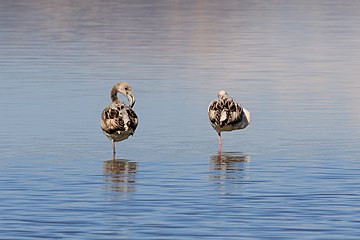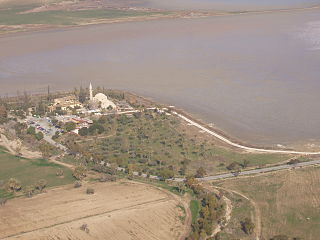Larnaca Salt Lake
| Larnaca Salt Lake | |
|---|---|
 in winter with part of Larnaca city in the background. | |
| Coordinates | 34°54′N 33°37′E / 34.900°N 33.617°E |
| Basin countries | Cyprus |
| Surface area | 1,585 ha (3,920 acres)[1] |
| Average depth | 1 m (3 ft 3 in) |
| Surface elevation | 0 m (0 ft) |
| Settlements | Larnaca |
| References | [1] |
| Designated | 11 July 2001 |
| Reference no. | 1081[2] |
Larnaca Salt Lake (
Besides its picturesque beauty, the lake is the haunt of 85 species of water-birds with estimated populations between 20,000 and 38,000.[
During the winter months the lake fills with water while in the summer the water evaporates, leaving a crust of salt and a haze of grey dust. According to legend, the lake's saltiness stems from St Lazarus' request to an old woman for food and drink. She refused, claiming her vines had dried up, to which Lazarus replied: "may your vines be dry and be a salt lake forever more."[9] A more scientific explanation is that the salt water penetrates the porous rock between the lake and the sea, making the water very salty.[citation needed]
Salt harvested from this lake used to be one of the island's major exports, being collected with donkeys, carried to the edge of the lake, and piled up into huge pyramidal heaps. With rising labour costs harvesting dwindled to a negligible amount and stopped altogether in 1986[3] as the island now imports most of this commodity.[citation needed]
Gallery
-
Flamingos on the lake
-
Aerial photo of the Larnaca Salt Lake (in winter) with Hala Sultan Tekke
References
- ^ a b "The Annotated Ramsar List: Cyprus". Ramsar Convention Secretariat. 24 August 2001. Archived from the original on 29 June 2008. Retrieved 6 June 2016.
- ^ "Larnaca Salt Lake". Ramsar Sites Information Service. Retrieved 25 April 2018.
- ^ a b c "Report of the environmental audit of the city of Larnaca" (PDF). Medcities. May 1999. Retrieved 2007-03-29.
- ^ Kassinis, Nicolaos; Michalis Antoniou (October 2006). "Proceedings of the first symposium on the Mediterranean action plan for the conservation of marine and coastal birds (p94)" (PDF). Archived from the original (PDF) on September 29, 2007. Retrieved 2007-03-29.
- ^ Iezekiel S., Makris C., Antoniou A. (2004) Important Bird Areas of European Union Importance in Cyprus. Birdlife Cyprus, Lefkosia 2004.
- ^ "BirdLife IBA Factsheet - Larnaca salt-lake". BirdLife International. 2006. Retrieved 2007-03-25.
- ^ Hadjichristoforou, Myroula (8 December 2004). "5th European Regional Meeting on the implementation and effectiveness of the Ramsar Convention" (PDF). Ramsar. Archived from the original (PDF) on January 6, 2006. Retrieved 2007-03-25.
- S2CID 21090604.
- ^ "Saint Lazare in Larnaca". Damianos Foundation. Archived from the original on 2007-09-30. Retrieved 2007-04-16.
External links
 Media related to Larnaca Salt Lake at Wikimedia Commons
Media related to Larnaca Salt Lake at Wikimedia Commons



